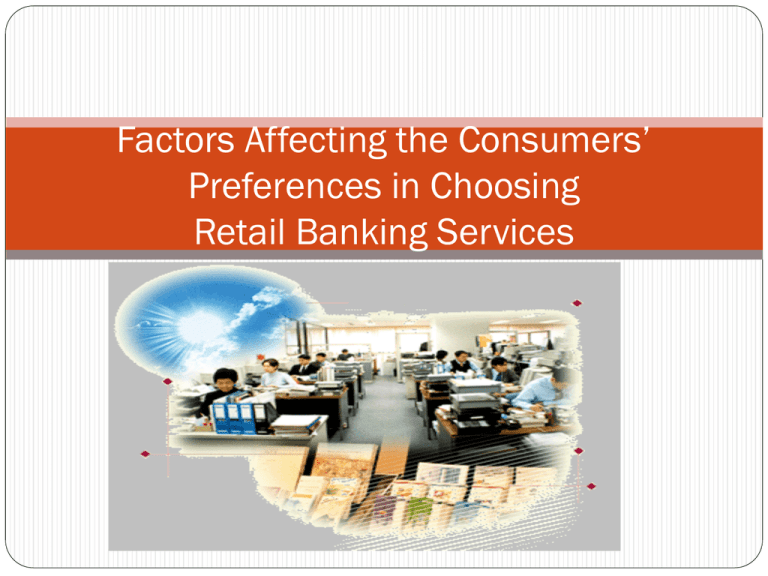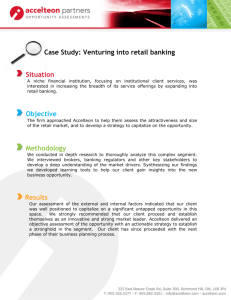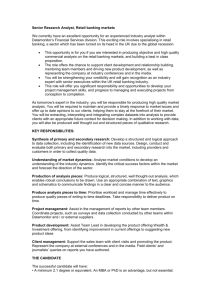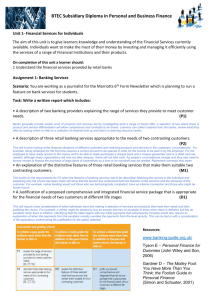Factors Affecting the Consumers' Preferences in Choosing Retail
advertisement

Factors Affecting the Consumers’ Preferences in Choosing Retail Banking Services What is Retail Banking? Retail banking refers to banking in which banks transact directly with consumers. It aims to be the one-stop shop for as many financial services as possible on behalf of retail clients. Retail banks have their own objectives like increasing revenue growth, improving customer service, cutting costs etc. Growth factors for retail banking in India: Indian economy is growing, the retail banking as an industry is also growing (CAGR over 35% for the last five years). There are many other factors like growing disposable income, presence of largest youngest population of the world, increasing literacy levels, improved lifestyles etc, which are acting as the driving force for the growth of the retail banking sector. Opportunities and Challenges: One of the major challenges is to increase the customer base. The main reason for this is the entrance of the new players due to globalization, consumers having considerable choices in satisfying their needs etc. Retail Banks cannot stop the entry of the new players but they can certainly satisfy the needs of the consumers to a maximum extent and increase their consumer base, which will in turn increase the revenue growth, which is one of the objectives of the retail banks. Thus, it becomes crucial for the banks to understand the consumers’ preferences when they choose retail banking services. Understanding the expectations of the consumers will be helpful in making different strategies and develop new options from which the customer can choose from and be HAPPY. Methodology: This study is based on the same i.e. to understand the factors affecting the consumers’ behavior in choosing the retail banking services. In the study, we designed a questionnaire keeping 28 variables and it was distributed to the respondents of the age group from 20 to 30, which constitute a quarter of India's earnings. After analyzing the responses, 9 factors (augmented facilities, credit facilities, transaction facilities, availability, e-commerce, brand image, ambience, operational convenience, personal attention), which have a major influence on the consumers’ behavior in choosing a retail banking services. Factors chosen to differentiate Factor 1 – Augmented Facilities –Phone banking, call centre facility, mobile banking. Factor 2 – Credit Facilities – Banking charges of a bank, credit card facility, interest rate and credit allowance, credit overdraft policy of the bank. Factor 3 – Transaction Facilities – The limit on number of transactions, cheques at par facility, collection of outstation cheques facility, customized account. Factor 4 – Availability – Numbers of branches, number of ATM centres, presence of bank in other cities and number of ATM transactions. Contd.. Factor 5 – E-Commerce –Anywhere cash deposit facility, electronic transfer facility, online banking, Factor 6 – Brand Image –Minimum balance criteria, brand image of bank. Factor 7 – Ambience –Ambience of the bank, promotions of the bank Factor 8 – Operational Convenience – Banking hours, number of ATM TRANSACTIONS Factor 9 – Personal Attention – Drop and pick facility of cheques, pleasant interaction with bank employees, and ease of opening an account. ANALYSIS AND INFERENCE Sent out a total of 200 questionnaires to our sample population comprising of individual of age group 22 – 27 years. Response Rate of the survey – 87.5 % ( 175 out of 200 ) Error percentage – 14.28% ( 25 out of 175 ) The remaining 150 questionnaires were used for our further calculation and analysis. The gender break-up of the sample is 109 males and 41 females. CONCLUSION The main factor which was found to be highly affecting the choice of bank among our survey sample differentiating a public sector bank from private sector bank was identified to be the ambience of the bank and promotion of the brand. Presence of bank in various cities, service time, number of branches and number of ATM centers also equally affect the preference of consumers. FUTURE SCOPE Since the model explains 28% of the variance in the factors observed, it leaves a future scope for identifying all such other quantifiable and non–quantifiable factors to develop a more realistic relationship to describe the customer behavior towards choice of a retail bank in a holistic manner.






